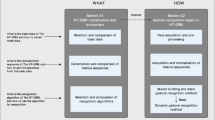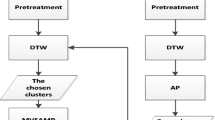Abstract
In previous research on human machine interaction, parameters or templates of gestures are always learnt from training samples first and then a certain kind of matching is conducted. For these training-required methods, a small number of training samples always result in poor or user-independent performance, while a large quantity of training samples lead to time-consuming and laborious sample collection processes. In this paper, a high-performance training-free approach for hand gesture recognition with accelerometer is proposed. First, we determine the underlining space for gesture generation with the physical meaning of acceleration direction. Then, the template of each gesture in the underlining space can be generated from the gesture trails, which are frequently provided in the instructions of gesture recognition devices. Thus, during the gesture template generation process, the algorithm does not require training samples any more and fulfills training-free gesture recognition. After that, a feature extraction method, which transforms the original acceleration sequence into a sequence of more user-invariant features in the underlining space, and a more robust template matching method, which is based on dynamic programming, are presented to finish the gesture recognition process and enhance the system performance. Our algorithm is tested in a 28-user experiment with 2,240 gesture samples and this training-free algorithm shows better performance than the traditional training-required algorithms of Hidden Markov Model (HMM) and Dynamic Time Warping (DTW).









Similar content being viewed by others
Notes
c(x,y) is smaller (lower cost) when x and y are more similar to each other.
The EM algorithm used in HMM is also called Baum Welch Algorithm.
The Sum-Product Algorithm used in HMM is also called Forward-backward Algorithm.
The lasting time for each atomic gesture to continue will be considered in the step of matching.
Number d here indicates the underlining state of z d for simplicity.
References
Adxl330 datasheet (2006)
Akl A, Valaee S (2010) Accelerometer-based gesture recognition via dynamic-time warping, affinity propagation, & compressive sensing. In: 2010 IEEE international conference on acoustics speech and signal processing (ICASSP), IEEE, pp 2270–2273
Brezmes T, Gorricho JL, Cotrina J (2009) Activity recognition from accelerometer data on a mobile phone. In: Distributed computing, artificial intelligence, bioinformatics, soft computing, and ambient assisted living, pp 796–799
Brindza J, Szweda J, Liao Q, Jiang Y, Striegel A (2009) Wiilab: bringing together the nintendo wiimote and matlab. In: Frontiers in education conference, 2009. FIE’09. 39th IEEE. IEEE, pp 1–6
Byrne D, Doherty AR, Snoek CGM, Jones GJF, Smeaton AF (2010) Everyday concept detection in visual lifelogs: validation, relationships and trends. Multimed Tools Appl 49(1):119–144
Chen Y, Liu M, Liu J, Shen Z, Pan W (2011) Slideshow: Gesture-aware ppt presentation. In: 2011 IEEE international conference on multimedia and expo (ICME), IEEE, pp 1–4
Cho SJ, Oh JK, Bang WC, Chang W, Choi E, Jing Y, Cho J, Kim DY (2004) Magic wand: a hand-drawn gesture input device in 3-d space with inertial sensors
Choi ES, Bang WC, Cho SJ, Yang J, Kim DY, Kim SR (2005) Beatbox music phone: gesture-based interactive mobile phone using a tri-axis accelerometer. In: IEEE international conference on industrial technology, 2005. ICIT 2005. IEEE, pp 97–102
Farella E, Pieracci A, Benini L, Rocchi L, Acquaviva A (2008) Interfacing human and computer with wireless body area sensor networks: the wimoca solution. Multimed Tools Appl 38(3):337–363
Flórez F, García JM, García J, Hernández A (2002) Hand gesture recognition following the dynamics of a topology-preserving network. In: Fifth IEEE international conference on automatic face and gesture recognition, 2002. Proceedings. IEEE, pp 318–323
Holzinger A, Nischelwitzer AK, Kickmeier-Rust MD (2006) Pervasive e-education supports life long learning: some examples of x-media learning objects (xlo). Digital Media, pp 20–26
Holzinger A, Softic S, Stickel C, Ebner M, Debevc M (2009) Intuitive e-teaching by using combined hci devices: experiences with wiimote applications. In: Universal access in human-computer interaction. applications and services, pp 44–52
Holzinger A, Softic S, Stickel C, Ebner M, Debevc M, Hu B (2012) Nintendo wii remote controller in higher education: development and evaluation of a demonstrator kit for e-teaching. Comput Inform 29(4):601–615
Hürst W, van Wezel C (2012) Gesture-based interaction via finger tracking for mobile augmented reality. Multimed Tools Appl 62(1):233–258
Kettebekov S, Sharma R (2000) Understanding gestures in multimodal human computer interaction. Int J Artif Intell Tools 9(2):205–223
Lee HK, Kim JH (1999) An hmm-based threshold model approach for gesture recognition. IEEE Trans Pattern Anal Mach Intell 21(10):961–973
Liu J, Zhong L, Wickramasuriya J, Vasudevan V (2009) uwave: accelerometer-based personalized gesture recognition and its applications. Pervasive Mob Comput 5(6):657–675
Mäntyjärvi J, Kela J, Korpipää P, Kallio S (2004) Enabling fast and effortless customisation in accelerometer based gesture interaction. In: ACM international conference proceeding series
Mantyla VM, Mantyjarvi J, Seppanen T, Tuulari E (2000) Hand gesture recognition of a mobile device user. In: 2011 IEEE international conference on multimedia and expo (ICME), vol 1. IEEE, pp 281–284
Montoliu R, Blom J, Gatica-Perez D (2013) Discovering places of interest in everyday life from smartphone data. Multimed Tools Appl 62(1):179–307
Montoliu R, Gatica-Perez D (2010) Discovering human places of interest from multimodal mobile phone data. In: Proceedings of the 9th international conference on mobile and ubiquitous multimedia. ACM, p 12
Müller M (2007) Ltd MyiLibrary. Information retrieval for music and motion, vol 6. Springer Berlin
Park CB, Roh MC, Lee SW (2008) Real-time 3d pointing gesture recognition in mobile space. In: 8th IEEE international conference on automatic face & gesture recognition, 2008. FG’08. IEEE, pp 1–6
Pavlovic VI, Sharma R, Huang TS (1997) Visual interpretation of hand gestures for human-computer interaction: a review. IEEE Trans Pattern Anal Mach Intell 19(7):677–695
Pei M, Jia Y, Zhu SC (2011) Parsing video events with goal inference and intent prediction. In: 2011 IEEE international conference on computer vision (ICCV), IEEE, pp 487–494
Peng X, Bennamoun M, Mian AS (2011) A training-free nose tip detection method from face range images. Pattern Recogn 44(3):544–558
Quintana GE, Sucar LE, Azcárate G, Leder R (2008) Qualification of arm gestures using hidden markov models. In: 8th IEEE international conference on automatic face & gesture recognition, 2008. FG’08. IEEE, pp 1–6
Rabiner LR (1989) A tutorial on hidden markov models and selected applications in speech recognition. Proc IEEE 77(2):257–286
Rabiner LR, Juang BH (1993) Fundamentals of speech recognition
Rajko S, Qian G (2008) Hmm parameter reduction for practical gesture recognition. In: 8th IEEE international conference on automatic face & gesture recognition, 2008. FG’08. IEEE, pp 1–6
Seo HJ, Milanfar P (2010) Training-free, generic object detection using locally adaptive regression kernels. IEEE Trans Pattern Anal Mach Intell 32(9):1688–1704
Sminchisescu C, Kanaujia A, Li Z, Metaxas D (2005) Conditional models for contextual human motion recognition. In: Tenth IEEE international conference on computer vision, 2005. ICCV 2005, vol 2. IEEE, pp 1808–1815
Song Y, Demirdjian D, Davis R (2011) Multi-signal gesture recognition using temporal smoothing hidden conditional random fields. In: 2011 IEEE international conference on automatic face & gesture recognition and workshops (FG 2011), IEEE, pp 388–393
Suk HI, Sin BK, Lee SW (2008) Recognizing hand gestures using dynamic bayesian network. In: 8th IEEE international conference on automatic face & gesture recognition, 2008. FG’08. IEEE, pp 1–6
Takahashi M, Fujii M, Naemura M, Satoh S (2013) Human gesture recognition system for tv viewing using time-of-flight camera. Multimed Tools Appl 62(3):761–783
Tsukada K, Yasamura M (2002) Ubi-finger: gesture input device for mobile use. In: Asia-Pacific computer and human interaction
Wang D, Xiong Z, Zhang M (2012) An application oriented and shape feature based multi-touch gesture description and recognition method. Multimed Tools Appl 58(3):497–519
Wilson A, Shafer S (2003) Xwand: Ui for intelligent spaces. In: Computer human interaction, pp 545–552
Wilson D, Wilson A (2004) Gesture recognition using the xwand
Wu J, Pan G, Zhang D, Qi G, Li S (2009) Gesture recognition with a 3-d accelerometer. In: Ubiquitous intelligence and computing, pp 25–38
Zhu Y, Xu G, Kriegman DJ (2002) A real-time approach to the spotting, representation, and recognition of hand gestures for human–computer interaction. Comput Vis Image Underst 85(3):189–208
Author information
Authors and Affiliations
Corresponding author
Rights and permissions
About this article
Cite this article
Yin, L., Dong, M., Duan, Y. et al. A high-performance training-free approach for hand gesture recognition with accelerometer. Multimed Tools Appl 72, 843–864 (2014). https://doi.org/10.1007/s11042-013-1368-1
Published:
Issue Date:
DOI: https://doi.org/10.1007/s11042-013-1368-1




